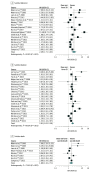Visual Impairment and Suicide Risk: A Systematic Review and Meta-Analysis
- PMID: 38630473
- PMCID: PMC11024775
- DOI: 10.1001/jamanetworkopen.2024.7026
Visual Impairment and Suicide Risk: A Systematic Review and Meta-Analysis
Erratum in
-
Error in Author Affiliations.JAMA Netw Open. 2024 May 1;7(5):e2418308. doi: 10.1001/jamanetworkopen.2024.18308. JAMA Netw Open. 2024. PMID: 38771583 Free PMC article. No abstract available.
Abstract
Importance: Suicide is a substantial public health concern that involves various recognized contributing factors. Sensory impairments, specifically visual impairment, are deemed potential risk factors. Nonetheless, comprehensive information about associated risk levels and underlying determinants remains limited.
Objective: To investigate the association between visual impairment and different aspects of suicide, including the assessment of risk levels and exploration of potential contributing factors.
Data sources: An electronic search was performed in the PubMed, EMBASE, Scopus, and Cochrane Library databases from their inception to February 8, 2024.
Study selection: All published studies were considered without restrictions on study design, publication date, or language.
Data extraction and synthesis: Two independent reviewers extracted the published data using a standardized procedure in accordance with the Meta-analysis of Observational Studies in Epidemiology (MOOSE) and Preferred Reporting Items for Systematic Reviews and Meta-analyses (PRISMA) reporting guidelines. Random-effects meta-analyses were used to estimate pooled effect sizes. Multiple meta-regression analyses were conducted to identify potential factors contributing to the association between visual impairment and the risk of suicide.
Main outcomes and measures: The primary outcome measure was the odds ratio (OR) of suicidal behavior (including suicide attempt and suicide death) for individuals with visual impairment compared with those without. The secondary outcome measures were the pooled ORs of suicidal ideation and suicide death, respectively.
Results: A total of 31 population-based studies with 5 692 769 unique individuals (mean [SD] age, 48.4 [8.5] years; 2 965 933 females [52%]) were included. For 17 studies (5 602 285 individuals) that evaluated suicidal behavior, the pooled OR was 2.49 (95% CI, 1.71-3.63). For 21 studies (611 899 individuals) that assessed suicidal ideation, the pooled OR was 2.01 (95% CI, 1.62-2.50). For 8 studies (5 067 113 individuals) investigating the association between visual impairment and suicide death, the pooled OR was 1.89 (95% CI, 1.32-2.71). The multiple meta-regression model identified age group as a predictive factor associated with suicidal behavior, with the studies included suggesting that adolescents were at the highest risk. While this analysis showed moderate heterogeneity for suicide death, high heterogeneity was observed for suicidal behavior and suicidal ideation.
Conclusions and relevance: The findings of this systematic review and meta-analysis support the association between visual impairment and increased risk of suicidal tendencies. The risk differed by age group, with a pronounced risk observed among adolescents.
Conflict of interest statement
Figures



References
-
- World Health Organization . Preventing Suicide: A Global Imperative. World Health Organization; 2014.
-
- May AM, Klonsky ED. What distinguishes suicide attempters from suicide ideators? a meta-analysis of potential factors. Clin Psychol Sci Pr. 2016;23(1):5. doi: 10.1037/h0101735 - DOI
Publication types
MeSH terms
LinkOut - more resources
Full Text Sources
Medical

